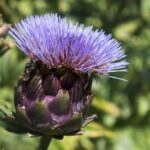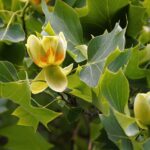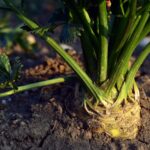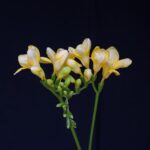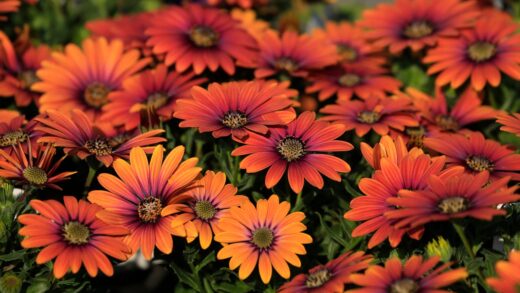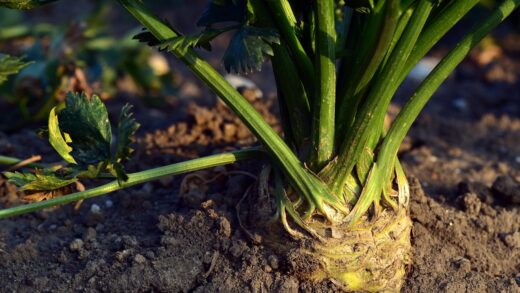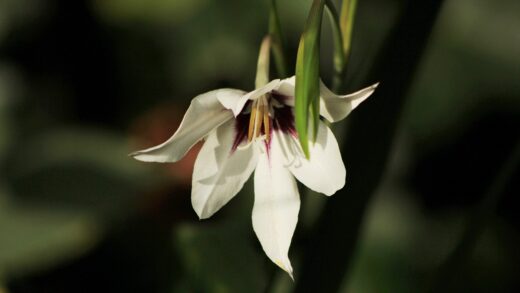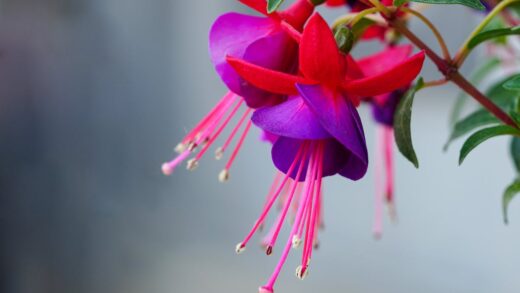The flowering almond, also known as Prunus triloba, is a stunning spring-blooming ornamental shrub that fills any garden with life with its pink, double flowers. This plant originates from China and belongs to the Rosaceae family, which in itself guarantees an unparalleled floral display. With proper care, the flowering almond repays the attention with abundant blooms year after year, becoming one of the most beautiful jewels of the garden in the early spring period. For the plant to be long-lived and healthy, it is important to know its basic needs, from pruning to plant protection. This article details all the tasks necessary to ensure the optimal development and flowering of the flowering almond.
The flowering almond is a relatively short, deciduous shrub or small tree that typically grows to a height of 1.5-2.5 meters. Its top-grafted varieties are particularly popular, as they can be shaped into a small tree with a regular, rounded crown, making it a spectacular solitary feature. Its flowers open in April, before the leaves appear, densely covering the previous year’s shoots, as if the whole plant were enveloped in a cloud of cotton candy. This early flowering makes it truly special, as it is among the first to bring color and cheerfulness to the garden after the grayness of winter. The flowers are double, pink, and bear a striking resemblance to miniature roses.
Among the plant’s morphological characteristics is that the flowers appear on the shoots developed in the previous year, which fundamentally determines the correct timing of its pruning. Its leaves only emerge after flowering; they are simple, lanceolate or ovate, and have slightly serrated edges. The color of the leaves is a fresh green, which provides ornamental value to the shrub even after the flowering period. Although the plant is primarily decorative for its flowers, its dense, orderly foliage also provides a beautiful sight in summer.
There are two basic types available in nurseries: the bush form and the top-grafted, so-called standard tree form. The bush form creates a more natural effect and fits well into mixed shrub beds or can even be grown as a hedge. The standard flowering almond, on the other hand, is an ideal choice for more formal gardens, front yards, or even as a potted plant on a terrace. The care requirements for both varieties are the same, but different considerations must be taken into account during their pruning to maintain the desired shape.
The ideal planting location and soil preparation
The flowering almond prefers sunny locations, so choose a spot in your garden where it receives at least six hours of direct sunlight daily. Abundant light is essential for rich flowering; in shady or semi-shady places, the number of flowers may significantly decrease, and the plant’s shoot system will become elongated and sparse. Sunlight also helps the foliage to dry quickly, which reduces the risk of fungal diseases, especially monilinia brown rot. South or west-facing parts of the garden are ideal for it.
It is relatively tolerant of soil type, but it shows the best development in well-drained, nutrient-rich, slightly alkaline or neutral (pH 6.5-7.5) soils. Soils that are too heavy and clayey, where water tends to stagnate, should be avoided at all costs, as standing water can lead to root rot. Before planting, it is worth improving such soils with sand, compost, or well-rotted manure to improve structure and drainage. Loose, sandy soils can also be suitable, but they need to be enriched with organic matter to better retain moisture and nutrients.
Pre-planting soil preparation is a crucial step in establishing the long-term health of the plant. When digging the planting hole, make sure it is at least twice as wide and deep as the plant’s root ball. Mix the excavated soil with good quality potting soil, compost, or mature manure. This loose, nutrient-rich medium stimulates rapid root growth and makes it easier for the young plant to establish itself. It is a good idea to place a layer of gravel or clay granules at the bottom of the hole to further improve drainage.
When choosing a location, also think about the final size of the plant. Although the flowering almond does not grow excessively large, provide it with enough space to grow so that its crown can develop freely and it does not have to compete with neighboring plants for light and nutrients. For top-grafted varieties, it is particularly important that the crown does not touch walls or other plants, as this can lead to damage and obstruct air circulation, which is also a breeding ground for fungal diseases. A well-chosen location will ensure the plant’s beauty for decades.
The tricks of planting
The most ideal time to plant the flowering almond is in the spring or autumn, when the soil is or has become sufficiently warm, but the extreme summer heat or winter frosts have not yet set in. The advantage of autumn planting is that the plant has time to strengthen its root system over the winter, so it can start growing more vigorously in the spring. Spring planting is also a good choice, especially for younger, more frost-sensitive specimens. A container-grown plant can be planted practically anytime during the frost-free period, but planting in the summer heat requires more intensive watering.
The first step of planting is to dig a planting hole of the appropriate size, which, as mentioned earlier, should be at least twice the size of the root ball. Carefully remove the plant from the container, and if the roots have densely woven around the root ball, gently loosen them with your fingers. This encourages the roots to spread into the new soil. Place the plant in the center of the hole so that the top of the root ball is level with or slightly above the surrounding soil level. Never plant it deeper, as this can lead to trunk rot, especially in grafted varieties where the graft union must remain above the ground.
Once you have positioned the plant in the hole, start backfilling it with the improved soil mixture, gently tamping it down to ensure there are no air pockets around the roots. When the hole is half full, water it thoroughly to allow the soil to settle around the roots. Then, fill the hole completely with the remaining soil and create a small basin around the trunk to help retain irrigation water. The thorough, settling watering after planting is the most important step for successful establishment.
In the weeks after planting, the plant is particularly vulnerable and requires regular watering. Make sure its soil remains slightly moist, but not waterlogged. You can cover the soil surface with mulch (e.g., pine bark or wood chips), which helps to retain soil moisture, prevents weed growth, and protects the root system from temperature fluctuations. The mulch layer should not directly touch the plant’s trunk; leave a small gap to ensure ventilation.
Watering and nutrient supply
The water requirement of the flowering almond is considered moderate, but a balanced water supply is essential for its successful cultivation. Freshly planted specimens should be watered thoroughly and regularly in the first year, at least once a week, especially during dry, drought periods. The goal is for moisture to reach the deeper layers of the soil, which encourages the development of a deeper root system. Well-established, older plants are significantly more tolerant of drought, but during long periods without rain, especially before and during flowering, they are grateful for supplementary watering. When watering, always apply the water to the base of the plant, avoiding wetting the foliage, as this can promote the spread of fungal diseases.
Nutrient supply is one of the keys to abundant flowering. In spring, at the beginning of the growing season, before bud break, it is advisable to apply a dose of slow-release, complex fertilizer to the soil around the plant. Choose a product that contains a balanced ratio of the main macronutrients (nitrogen, phosphorus, potassium). Phosphorus is particularly important for flower formation, while potassium increases the plant’s overall resistance to diseases and stress. Alternatively, you can use organic fertilizer, such as mature compost or manure, spread in a thin layer around the trunk and then gently worked into the soil.
During the growing season, especially after flowering when the plant is developing next year’s flower buds, it will appreciate further nutrient supplementation. At this time, you can apply a liquid fertilizer every two weeks or once a month with the irrigation water. However, be aware that excessive nitrogen intake can stimulate excessive vegetative growth at the expense of flowering, so from the second half of summer, use a fertilizer with a higher phosphorus and potassium content. Stop fertilizing at the end of August to allow the new shoots to mature before winter sets in.
The sign of proper nutrition is healthy, dark green foliage and a high yield of flowers. If the leaves start to turn yellow (and this is not a sign of overwatering), or flowering is sparse, it may indicate a nutrient deficiency. In this case, you can quickly remedy the problem with a fast-acting, water-soluble fertilizer. However, moderation is important; over-fertilizing can be at least as harmful as a nutrient deficiency and can lead to root burn. Always follow the dosage instructions on the packaging of the chosen product.
The art and importance of pruning
Pruning the flowering almond is one ofthe most important care operations, essential for maintaining the plant’s health, ensuring abundant flowering, and shaping it as desired. The most important rule is that pruning should always be done immediately after flowering. Since the flowers develop on the previous year’s shoots, pruning in early spring or winter would remove the flower buds, and the floral display for that year would be lost. Pruning after flowering, however, gives the plant enough time to develop new shoots on which the flowers will appear the following spring.
The first and most important step in pruning is to cut back the shoots that bore the faded flowers. These shoots should be cut back by about half or two-thirds. This seemingly drastic intervention stimulates the plant to grow new, vigorous shoots that will be full of flower buds for the next season. In addition, this method helps to prevent the spread of the flowering almond’s main enemy, monilinia brown rot, as the pathogen often infects through the faded flowers and overwinters on the shoots. By cutting back, you also remove the infected parts.
Pruning also includes shaping the plant and thinning out the crown. All inward-growing, crossing, weak, or damaged branches must be removed. The goal is to create a loose, airy crown structure where air and sunlight can reach every branch. This not only makes the plant more attractive aesthetically but also plays a key role in preventing fungal diseases. For top-grafted varieties, pay attention to maintaining a regular, rounded shape, and for the bush form, create a natural but tidy habit.
Always use clean and sharp tools for pruning, such as pruning shears or loppers. Dull tools crush the plant tissues, which hinders wound healing and opens the door for pathogens. After each cut, but especially if you have removed a diseased-looking branch, disinfect the tool’s blade with alcohol or a bleach solution to prevent the transmission of infections from one plant to another, or even from one part of the plant to another. The pruning debris, especially the parts suspected of being infected, should be destroyed immediately, not composted.
Protection against common diseases and pests
The most significant and common disease of the flowering almond is monilinia blight and shoot dieback, caused by the fungus Monilinia laxa. The typical symptom of the infection is that the flowers and young shoots suddenly wilt, turn brown, and dry out, as if they had been hit by frost or fire. The infection enters the plant through the flowers and travels down the shoots, eventually capable of destroying entire branches. The basis of control is prevention: the correct pruning technique, i.e., immediate and radical pruning after flowering, which removes a large part of the infected parts.
Preventive chemical control is also essential in the fight against monilinia. A dormant spray in early spring, before bud break, with copper or sulfur-based products helps to destroy the pathogens overwintering on the bark. The plant is particularly susceptible to infection during the flowering period, so it is advisable to spray with systemic fungicides effective against monilinia at the beginning and middle of flowering. In rainy, humid weather, the sprayings should be repeated more frequently, at intervals specified in the product’s authorization document. Immediately cut off and destroy infected, dried-out shoots and flowers, always making the cut in the healthy part.
In addition to fungal diseases, aphids can also frequently appear on the flowering almond, especially on the tips of young, tender shoots. The aphids weaken the plant with their sucking, distort the leaves, and excrete honeydew on which sooty mold can develop. For a minor infestation, you can wash the aphids off with a strong jet of water or use natural-based products, such as potassium soap or orange oil solution. For a stronger infestation, the use of insecticides may become necessary.
Other pests, such as scale insects or spider mites, can also occur, though less frequently, especially on weakened, stressed plants. Scale insects live under a small, shield-shaped protective layer on the branches and leaves, while spider mites suck on the underside of the leaves, creating a fine web. Prevention here also lies in keeping the plant in good condition. The spring dormant spray is also effective against scale insects. Spider mites prefer dry, warm conditions, so regular misting or occasionally hosing down the foliage (but not in direct sun!) can help prevent their proliferation.
Propagation methods and winter care
The most common method of propagating the flowering almond is by hardwood or semi-hardwood cuttings. Semi-hardwood cuttings should be taken in mid-summer, and hardwood cuttings in autumn, after leaf fall. Choose a healthy, pencil-thick shoot and cut a piece about 15-20 cm long from it. Remove the lower leaves of the cutting, leaving only the top 2-3 leaves. Dip the lower cut surface in rooting hormone, then stick it in a loose, sandy, moist medium. Cover the cuttings with a transparent plastic film or bottle to ensure humidity, and keep them in a bright, but not directly sunny, place. Rooting can take weeks, even months.
Another common propagation method is layering, which is a simple procedure with a high success rate. In spring, select a low-growing, flexible shoot and bend it down to the ground without breaking it. On the part that touches the ground, slightly scrape or cut the bark to stimulate root formation. Secure the shoot to the soil with a wire hook, then mound soil over it. Leave the tip of the shoot above the ground. Keep the soil around the layer consistently moist. The new plant will usually develop enough roots by the following spring to be separated from the mother plant and transplanted to its final location.
Grafting is the professional method for producing the standard, top-grafted varieties available in nurseries. This involves grafting a noble shoot of the flowering almond onto a suitable rootstock (usually a species of wild cherry or plum). This method requires expertise and practice, so it is rarely used in home conditions. For grafted plants, it is important to watch for suckers that may emerge from the rootstock and remove them immediately from the base, as they would take energy away from the noble crown.
The flowering almond is fully hardy, so established specimens planted in the garden do not require special winter protection. The root system of young, freshly planted plants should be covered with a thick layer of mulch (leaves, pine bark) for the first one or two winters to protect them from hard frosts. Plants grown in pots are more exposed to the risk of frost, as their root system is less protected. It is advisable to move a potted flowering almond to a frost-free but cool place for the winter, such as a garage or cellar, or if this is not possible, to wrap the pot thickly with burlap and bubble wrap, and place the plant next to a protected wall away from cold winds.



